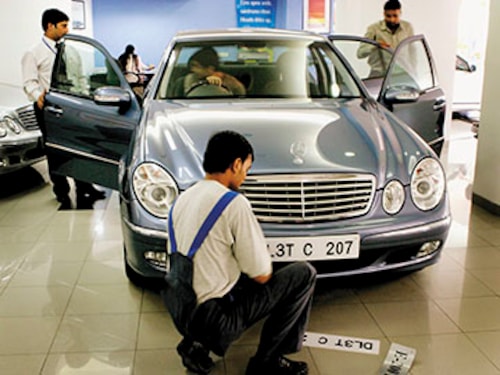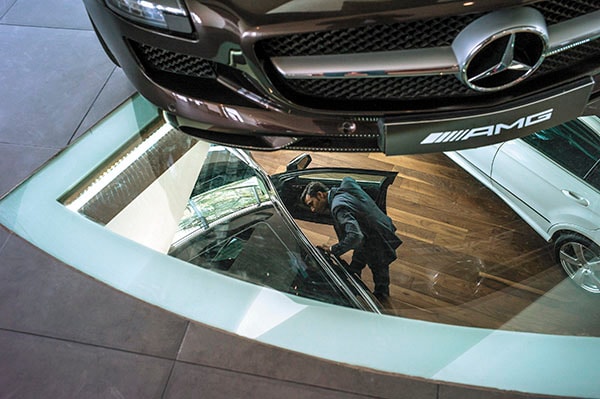Luxury auto industry can build on a strong 2015: Roland S Folger
India's burgeoning middle-class with their growing affluence and spending power portends well for the strong growth of the luxury car industry, and the economy as a whole


When I got the opportunity of heading the India operations of Mercedes-Benz, I was excited because India is a fast emerging market within the Mercedes-Benz world and the market growth achieved here is a regular discussion topic in Stuttgart, our headquarters. The enthusiasm is not unfounded when one glances at the steady growth rate of Mercedes-Benz in India in the past few years. From selling 5,000-odd cars even five years ago, we have already sold more than 10,000 cars in the first nine months this year and 2015 will be the best-ever year in the history of Mercedes-Benz in India. We have realised the potential of the Indian market and the growing economy, and, along with our dealer partners, have invested in the country. We see a lot of accomplishment in 2015 but I do firmly believe that 2016 could be a year of reckoning. What we need is faster implementation of all the plans and directives and to get started on measures that would make the auto industry the real lifeline of the Indian economy.
In 2015, the going has been strong like never before, given the multitude of factors that have worked for the luxury auto industry in general and Mercedes-Benz in particular. With the increasing number of India’s rich and affluent, owning a luxury car is no more a distant dream for many. The growing aspirations, buoyed by growing affluence, a stable economy and positive sentiment have been key aspects for luxury carmakers to perform well. With less than approximately 20 cars per 1,000 people, India has one of the lowest density of cars among all the BRIC countries. At an estimated 34,000 units of luxury cars sold in the calendar year 2014, the contribution of luxury cars is at a miniscule 1.3 percent of the overall automotive industry. This presents immense growth opportunities for the luxury sector in India. Compared to this, think of China where the luxury car contribution is at 7 percent of the total passenger car market and in the US it is even higher at around 11 to 12 percent. This only means we have more potential to explore emerging markets like India.
Mercedes-Benz India, for instance, has the densest luxury network among all luxury carmakers in India, but with 80 outlets in 41 cities we have a vast market that remains unexplored, and which introduces potential customers to luxury motoring. If we are able to take the contribution of luxury cars to even 4 to 5 percent in the next five years, we will see a lot more customers being able to own a luxury marquee like a Mercedes-Benz. However, this will only be possible with well thought-out initiatives from the government and many firm decisions to aid the growth of the industry in India.  Image: Getty Images
Image: Getty Images
Mercedes-Benz India expects the luxury car market to grow in low double digits this year
With the new government we have seen a lot more positive sentiments among our customers. We have seen early signs of progress in infrastructure projects, faster decision-making and a lot more ease in doing business. The ‘Make in India’ campaign in this context is visionary and has significant potential in making India a global powerhouse in manufacturing and competing in the international market. One of the key sectors that drives the government’s ‘Make in India’ campaign is the Indian automotive sector, as it is expected to reach an impressive volume of 9.4 million units of passenger vehicles by 2026, as is highlighted in the Auto Mission Plan (AMP) 2016-26. As the pioneers of luxury carmakers in India, we can confidently state that ‘Make in India’ is the cornerstone of an industrially resurgent India. To cite an instance, Mercedes-Benz India became the only country outside Germany to commence the local production of the highly exclusive Mercedes-Maybach sedan. That said, the path is half-travelled and a lot needs to be done. We are looking eagerly to the government initiatives and actions in 2016.
A few key areas where we need fast and firm decisions are the implementation of the Goods and Services Tax (GST), which is vital for the ease of doing business. The faster implementation of GST will surely have a uniform tax structure in all states and have a positive effect in the long-term impact on the competitiveness of the Indian auto industry. We also require a much simplified tax structure and a rational duty structure. The exorbitant import duty structure in India makes the price of luxury cars prohibitive and limits the growth potential of the sector. We believe implementation of such steps with a clear timeline will accelerate and sustain the growth in the automotive sector. I personally would hope to see the government taking the reform path with a strong determination for implementing the various announced plans.
The automotive industry’s growth and environmental concerns are closely entwined. The year 2016, I hope, should also be the year of reckoning again, in terms of progressive steps from the government on this subject. We desperately need introduction of Euro 6 engines in India, which are environment friendly and technologically advanced. If Euro 6 engines can be implemented in developed economies, there should be no reason why Indian customers shouldn’t be offered the latest engines and latest technologies that would benefit them. Short-term measures adopted like stopping the sale of diesel vehicles etc will not help the environment, as long as older vehicles aren’t taken off the roads, or even the quality of fuel available remains below standard, compared to other developed nations. It is essential that a more robust and efficient public transport system is developed and efforts are made to reduce emission levels and pollution. But it requires a balanced approach and a long-term vision.
I think 2016 has a lot of hope and aspirations in store for us as a country. The economy is looking to perform better next year and India’s burgeoning middle-class with their growing affluence and spending power is a good sign for the strong growth of the economy. This will further be spurred by low commodity prices and a stable inflation. We are confident that the domestic demand will remain strong in India and all automotive players are banking on this aspect. I see India playing an increasingly important role in the global economy along with China, and this sentiment is also based on the 2015 IMF’s World Economic Outlook, which puts India’s growth rate to rise above the other major emerging market economies. The IMF estimates India’s growth to strengthen from 7.3 percent in 2014-15 to 7.5 percent in the coming year. Here the government’s policy reforms come into the forefront even more, as more investment is likely to come to India with reforms and ease of trade. We have already invested Rs 1,000 crore in our production facility in Pune, and our dealers together have invested another Rs 750 crore in their facilities. It is obvious that with faster policy reforms comes higher investment and this is one of the areas in which we expect some progress.
Mercedes-Benz India expects the luxury car market to grow in low double digits this year and touch 40,000 units in annual sales. We, however, don’t see very high growth coming in the sector as a lot depends on policy changes. However, Mercedes-Benz will continue to have a double digit growth in 2016 and we are confident of maintaining our growth momentum. If one notices, even in 2014-15 the growth of luxury cars overall was muted and it was Mercedes-Benz that outgrew the other luxury brands and bucked the trend. We will continue our product offensive in 2016 as well and I think getting the customers excited and keeping them engaged with the brand is critical for any automotive brand.
We have seen that introductions of products create a lot of excitement in the market, increase showroom traffic significantly and give the dealer-partners opportunities to engage with their customer base. With the proportion of the HNI customer base growing several times by 2020, we expect more customers to reach the income level where they can actually afford buying a luxury car. It is also interesting to witness the gradual rise of markets beyond the major metros like Delhi, Mumbai, Chennai or Hyderabad and the steady emergence of tier II and III markets. Customers in markets like Dehradun, Bhopal, Rajkot, Baroda, Nashik, Jamshedpur, Mangalore, Coimbatore, Bhubaneswar, Kanpur or Lucknow can now experience the pleasure of owning a luxury car like Mercedes-Benz right in their city. There is also a lot of wealth generation in such smaller markets and we are ready with our plans to expand and tap the market potential there. Infrastructure development in this direction will be a key aspect in making such markets viable for a luxury brand like Mercedes-Benz to enter and sustain a growing business.
India’s reaching the top slots at the global automotive market by 2020 is still a distant call and 2016 can be a significant year in implementing decisions in that direction. I am hoping that if all the parameters for growth, including ease of business, are taken care of the luxury car industry will continue to post higher growth than the rest of the industry. India has been in the top 20 markets within Mercedes-Benz globally, but we are confident that by 2016 we will be featuring even stronger in that list. As I stated earlier, it’s a matter of great significance that India is more often discussed in the board rooms in headquarters than ever before, and I am sure it is the same for the other marquee brands as well. The coming year, I am sure, will bring in more good news for the automotive industry in India.
First Published: Jan 15, 2016, 06:19
Subscribe Now